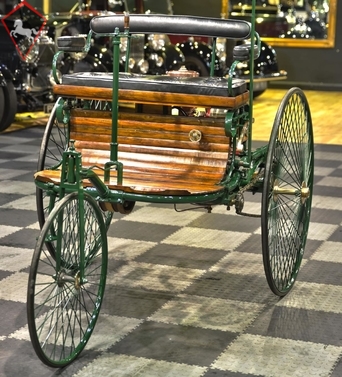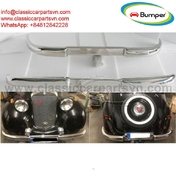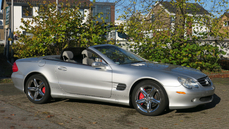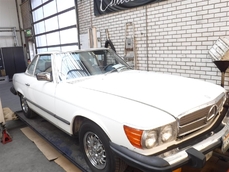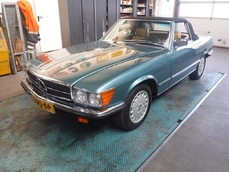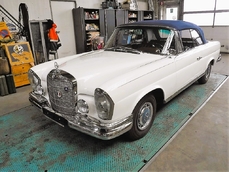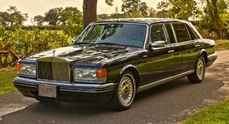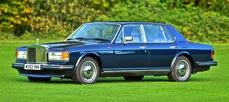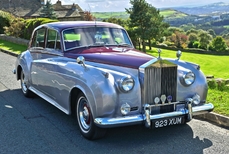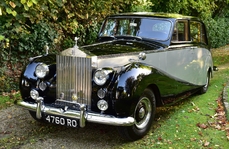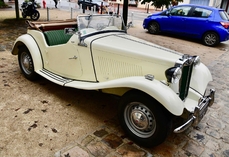Mercedes-Benz Other Motor Wagen 1901
General description :
View vehicle on YouTube
1886 Benz Patent Motor Wagen Replica.Chassis number: TBA
Registration number: TBA
Vintage and Prestige Fine Motor Cars are proud to be offering this 1886 Benz Patent-Motorwagen Replica for sale.
The Benz Patent-Motorwagen (or motorcar), built in 1886, is widely regarded as the world's first automobile. The original cost of the vehicle in 1885 was $1,000 (equivalent to $26,337 in 2016). This is an exact replica of the original, painstakingly constructed with reference to the original plans.The quality is superb making the Benz easy to drive. It is in brand new condition having just covered some bedding in miles.
This being the first model built after the production run for Mercedes-Benz. It was ordered to go into a prominent private car collection & aside from being run on the day of delivery it has had little use. When it arrived at our premises we re-commissioned her and she fired up straight away. It is in effect in brand new condition similar to the others we sell, this one being differentiated by the Green chassis as opposed to the more common black.
The original Benz Patent-Motorwagen was awarded the German patent, number 37435, for which Karl Benz applied on January 29, 1886. Following official procedures, the date of the application became the patent date for the invention once the patent was granted, which occurred in November of that year.
Although Benz's wife, Bertha, financed the development process and would hold patent rights under modern law as a married woman, she was not allowed to apply for the patent.
Benz officially unveiled his invention to the public on July 3, 1886, on the Ringstrasse (Ringstraße) in Mannheim.
About 25 Patent Motorwagens were built between 1886 and 1893.
The Benz Patent-Motorwagen was a three-wheeled automobile with a rear-mounted engine. The vehicle contained many new inventions. It was constructed of steel tubing with woodwork panels. The steel-spoked wheels and solid rubber tires were Benz's own design. Steering was by way of a toothed rack that pivoted the un-sprung front wheel. Fully elliptic springs were used at the back along with a live axle and chain drive on both sides. A simple belt system served as a single-speed transmission, varying torque between an open disc and drive disc.
The first Motorwagen used the Benz 954 cc single-cylinder four-stroke engine
With trembler coil ignition, this new engine produced 2⁄3 horsepower (0.50 kW) at 250rpm in the Patent-Motorwagen, although later tests by the University of Mannheim showed it to be capable of .9 hp (0.67 kW) at 400 rpm. It was an extremely light engine for the time, weighing about 100 kg (220 lb). Although it’s open crankcase and drip oiling system would be alien to a modern mechanic, its use of a pushrod operated poppet valve for exhaust would be quite familiar.
A large horizontal flywheel stabilized the single-cylinder engine's power output. An evaporative carburetor was controlled by a sleeve valve to regulate power and engine speed. The first model of the Benz Motorwagen had not been built with a carburetor, rather a basin of fuel soaked fibers that supplied fuel to the cylinder by evaporation.
Benz later made more models of the Motorwagen, model number 2 boasting 1.5 hp (1.1 kW), and model number 3 with 2 hp (1.5 kW), allowing the vehicle to reach a maximum speed of approximately 10 mph (16 km/h). The chassis was improved in 1887 with the introduction of wooden-spoke wheels, a fuel tank, and a manual leather shoe brake on the rear wheels.
Historic drive of Bertha Benz
The Benz Patent-Motorwagen Nr. 3 of 1888, used by Bertha Benz for the first long distance journey by automobile (more than 96 km or sixty miles)
Bertha Benz, married to Karl, chose to publicise the Patent-Motorwagen in a unique manner. She took the Patent-Motorwagen No.3, supposedly without her husband's knowledge, and drove it on the first long-distance automobile road trip to demonstrate its feasibility as a means to travel long distances. That trip occurred in early August 1888, as the entrepreneurial lady took her sons, Eugene and Richard who were fifteen and fourteen years old, respectively, on a ride from Mannheim through Heidelberg, and Wiesloch (where she took on ligroin as a fuel at the city pharmacy making it the first filling station in history), to her maternal hometown of Pforzheim.
As well as being the driver, Benz acted as mechanic on the drive, cleaning the carburetor with her hat pin and using a garter to insulate a wire. She refueled at the local pharmacy in Wiesloch and as the brakes wore down, Benz asked a local shoemaker to nail leather on the brake blocks, in doing so, inventing brake lining on the way. After sending a telegram to her husband of the arrival in Pforzheim, she spent the night at her mother's house and returned home three days later. The trip covered 194 km (121 mi) in total.
In Germany, a parade of antique automobiles celebrates this historic trip of Bertha Benz every two years. In 2008, the Bertha Benz Memorial Route was officially approved as a route of industrial heritage of mankind, because it follows Bertha Benz's tracks of the world's first long-distance journey by automobile in 1888. Now everybody can follow the 194 km (121 mi) of sign posted route from Mannheim via Heidelberg to Pforzheim (Black Forest) and back.
Finshed in a dark green to black leather this Benz patent motor wagen is the one to have!
The dark green paint is in good condtion so is the black leather
http://www.vintagerollsroycecars.com/sales/1516/1886-benz-patent-motor-wagen-replica/
1901 Mercedes-Benz Other Motor Wagen is listed sold on ClassicDigest in Grays by Vintage Prestige for Not priced.
Car Facts
Car type : Car Make : Mercedes-Benz Model : Other Model Version : Motor Wagen Engine size : 0.0 Model Year : 1901 Sub type : Pick up Location : Essex
Sold
Seller Information
Sold
People who viewed this Mercedes-Benz Other also viewed similar Mercedes-Benz listed at ClassicDigest
Other cars listed for sale by this dealer
About Mercedes-Benz
In the annals of automotive history, the journey of Mercedes-Benz is a tale that unfolds with the ingenuity of its founding pioneers. In the year 1886, Karl Benz crafted the Benz Patent Motorwagen, a creation that would go down in history as the world's inaugural automobile. Unbeknownst to him, this moment marked the genesis of what would evolve into the most illustrious premium car manufacturer globally. The financial underpinning of this pioneering venture, interestingly, was provided by Karl Benz's wife, Bertha Benz, demonstrating a remarkable partnership that would set the tone for Mercedes-Benz's legacy.A parallel narrative emerged not far away, as Daimler-Motoren-Gesellschaft, founded by Gottlieb Daimler and Wilhelm Maybach, entered the scene. In 1901, they unveiled their automobile under the now-famous moniker "Mercedes," meaning "godsend" in Spanish. This name was bestowed upon the car at the behest of Emil Jellinek's daughter, the distributor for Daimler-Motoren-Gesellschaft. The wheels of innovation were set in motion.
Fast forward to 1926, a pivotal year that witnessed the merger of Daimler with Benz & Cie., culminating in the birth of Daimler-Benz. The amalgamation saw the adoption of "Mercedes-Benz" as the distinguished trademark for their automobiles, fusing the legacies of two visionary entities into one.
Contrary to perceptions of conservatism, the trajectory of Daimler-Benz unfolds as a chronicle of industry firsts. From the introduction of the honeycomb radiator to the float carburetor, and the pioneering implementation of four-wheel brakes in 1924, Daimler-Benz consistently pushed the boundaries of automotive innovation. The diesel-powered Mercedes-Benz 260 D in 1936 marked the inception of diesel engines in passenger cars. The iconic Mercedes-Benz 300SL Gullwing made history as the first car with direct fuel injection, albeit the Gutbrod's tiny 2-stroke engine can claim precedence.
Safety innovations became a hallmark, with Béla Barényi's patented safety cell design in the "Ponton"-models in 1951, featuring front and rear crumple zones. The W116 450SEL 6.9 saw the introduction of the Anti-Lock Brake system (ABS), another pioneering safety feature. From the first production airbags and beyond, the legacy of "firsts" continued to be etched into the fabric of Daimler-Benz.
Over its centennial journey, Mercedes-Benz has not merely produced cars but has sculpted automotive icons. The SSKL, 710 SSK Trossi Roadster, 770K Grosser, 540K Spezial Roadster, 300SL Gullwing, w100 600 Pullman, w111 280SE 3.5 Flachkühler, w113 230SL Pagoda, w109 300 SEL 6.3, and w201 2.3-16 Cosworth stand testament to the brand's commitment to engineering excellence.
The roaring Silver Arrows, or "Silberpfeile," including the W 25, W 125, W154, W165, and W196, created a legacy of dominance on the racetrack. These machines were not merely cars; they were expressions of precision, speed, and an indomitable spirit that left their competitors in the dust.
As Mercedes-Benz marches into the future, it does so not just as an automaker but as a custodian of a legacy, a torchbearer of innovation, and a beacon of automotive excellence. The road ahead is sure to witness the continued fusion of cutting-edge technology, timeless design, and an unwavering commitment to setting new standards in the world of automobiles.
One luminary figure who left an indelible mark was Béla Barényi, often heralded as the "father of passive safety" for his pioneering work in safety engineering. His patented safety cell design, featuring front and rear crumple zones, became a hallmark of Mercedes-Benz's commitment to occupant safety, setting new standards that reverberated throughout the automotive world.
Moving through the chronicles, the collaborative genius of Wilhelm Maybach, alongside Gottlieb Daimler, laid the foundation for Daimler-Motoren-Gesellschaft. Their innovations not only birthed the first Mercedes but established a culture of relentless pursuit of technological excellence that remains integral to Mercedes-Benz's DNA.
In the post-merger era of 1926, Ferdinand Porsche emerged as a prominent figure within Mercedes-Benz. His work on the Mercedes-Benz S-Type, a supercharged race car, garnered acclaim and set the stage for a legacy that extended far beyond the marque. Porsche's impact would later extend to his eponymous company, but his influence at Mercedes-Benz during those formative years was pivotal.
As the 20th century progressed, the legendary Rudolf Uhlenhaut emerged as a key figure. Uhlenhaut, an accomplished engineer and the driving force behind the iconic Silver Arrows, played a crucial role in Mercedes-Benz's dominance in motorsports. His engineering prowess and attention to detail were instrumental in creating some of the most formidable racing cars of the era.
In the latter half of the century, figures like Bruno Sacco, the head of design at Mercedes-Benz from 1975 to 1999, left an indelible imprint on the brand's aesthetic identity. Sacco's design philosophy, characterized by clean lines and timeless elegance, shaped iconic models like the W126 S-Class and the W201 190E, solidifying Mercedes-Benz's reputation for luxury and sophistication.
The narrative would be incomplete without acknowledging the contributions of engineers like Hans Scherenberg, whose leadership in the 1970s ushered in a new era of technological innovation at Mercedes-Benz. Scherenberg's tenure saw the development of groundbreaking technologies, including the Anti-Lock Brake system (ABS) and the introduction of airbags in production cars.
